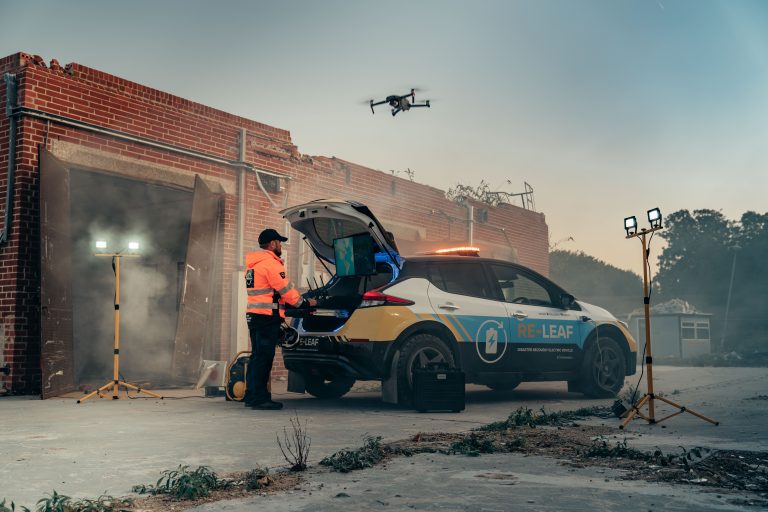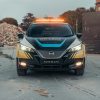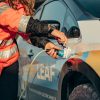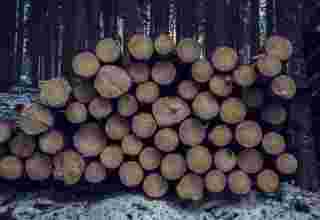
British engineers have transformed an electric car into an emergency response vehicle designed to provide a clean power supply to areas hit by natural disasters and extreme weather.
The Nissan RE-LEAF is based on the Sunderland-built LEAF family hatchback.
But instead of school-runs and motorway miles, the highly modified motor is better suited to navigating roads covered in debris on its way to the centre of a disaster zone.
The prototype has been designed to support the three ‘REs’ of disaster preparedness – providing an emergency response, aiding the humanitarian recovery and improving community resilience for the future.
It features weatherproof plug sockets mounted directly to the exterior of the vehicle, which enable 230v devices to be powered from the car’s high capacity lithium-ion battery.
As a result of its integrated energy management system, it can run medical, communications, lighting, and other life-supporting equipment.
And a bespoke pull-out desk extends from the boot with a 32” LED screen and dedicated power supply creating an operational hub to run communications from and manage the recovery process.
The time for electricity supply to be restored in a disaster zone is typically 24-48 hours, depending on the severity of the damage, but during that period electric vehicles can be used to provide a zero-emission, mobile emergency power supply.
Acting as a portable power station, the latest generation Nissan LEAF e+ with a fully charged 62 kilowatt-hour (kWh) battery can provide enough electricity to power the average household for six days.
As a disaster recovery vehicle, the RE-LEAF can power multiple devices.
Over a 24 hours period, it could power a water filtration unit, pressure ventilation fan, intensive care ventilator and LED flood lights.
Nissan worked with UK-based engineering and motorsport firm RJN on the project.
Helen Perry, head of electric passenger cars & infrastructure for Nissan in Europe, said: “Through Nissan Intelligent Mobility, we’re constantly exploring ways that electric vehicles can enrich our lives, beyond just zero-emission transportation.
“Concepts like the RE-LEAF show the possible application of EVs in disaster management and demonstrate that smarter, cleaner technology can help save lives and provide greater resilience for the future.
“Electric vehicles are emerging as one of the technologies that can improve resilience in the power sector.
“By having thousands of EVs available on standby, either as disaster-support vehicles or plugged into the network through Vehicle-to-Grid (V2G), they’re uniquely capable of creating a virtual power plant to maintain a supply of energy during a major outage.”
Dan Cooke, operations director at Serve On, the UK’s leading organisation providing emergency search and rescue in natural disasters around the world, added: “When responding to a disaster, two critical factors that make all the difference are establishing communications, and staying hydrated.
“Situational awareness saves lives and running a ‘command and control’ centre allows us to get the real picture of what’s happening whilst the infrastructure gets back online, but that needs power.
“Seeing the RE-LEAF is really exciting because we love exploring new ideas to see what’s possible.
“Looking back to previous scenarios we’ve dealt with, this technology could have made a real difference.
“For example, being able to power multiple filtration devices to produce thousands of litres of drinking water – essential in our line of work.”
jQuery(document).ready(function($) {
// We only want these styles applied when javascript is enabled
$(‘.gal_content’).css(‘display’, ‘block’);
// Initialize Advanced Galleriffic Gallery
var gallery = $(‘#thumbs_41782_1’).galleriffic({
delay: 3500,
numThumbs: 12,
preloadAhead: 12,
enableTopPager: false,
enableBottomPager: false,
imageContainerSel: ‘#slideshow_41782_1’,
controlsContainerSel: ‘#controls_41782_1’,
captionContainerSel: ‘#caption_41782_1’,
loadingContainerSel: ‘#loading_41782_1’,
renderSSControls: true,
renderNavControls: false,
playLinkText: ‘Play Slideshow’,
pauseLinkText: ‘Pause Slideshow’,
enableHistory: 0,
autoStart: 0,
enableKeyboardNavigation: true,
syncTransitions: false,
defaultTransitionDuration: 300,
onTransitionOut: function(slide, caption, isSync, callback) {
slide.fadeTo(this.getDefaultTransitionDuration(isSync), 0.0, callback);
caption.fadeTo(this.getDefaultTransitionDuration(isSync), 0.0);
},
onTransitionIn: function(slide, caption, isSync) {
var duration = this.getDefaultTransitionDuration(isSync);
slide.fadeTo(duration, 1.0);
// Position the caption at the bottom of the image and set its opacity
var slideImage = slide.find(‘img’);
caption.fadeTo(duration, 1.0);
},
onPageTransitionOut: function(callback) {
//this.hide();
setTimeout(callback, 100); // wait a bit
},
onPageTransitionIn: function() {
var prevPageLink = this.find(‘a.prev’).css({‘opacity’: ‘0.3’ , ‘display’ : ‘inline-block’, ‘cursor’ : ‘default’});
var nextPageLink = this.find(‘a.next’).css({‘opacity’: ‘0.3’ , ‘display’ : ‘inline-block’, ‘cursor’ : ‘default’});
// Show appropriate next / prev page links
if (this.displayedPage > 0)
prevPageLink.css({‘opacity’ : ‘1’ , ‘display’ : ‘inline-block’, ‘cursor’ : ‘pointer’});
var lastPage = this.getNumPages() – 1;
if (this.displayedPage < lastPage)
nextPageLink.css({'opacity' : '1' , 'display' : 'inline-block', 'cursor' : 'pointer'});
this.fadeTo('fast', 1.0);
}
});
/**************** Event handlers for custom next / prev page links **********************/
gallery.find('a.prev').click(function(e) {
gallery.previousPage();
e.preventDefault();
});
gallery.find('a.next').click(function(e) {
gallery.nextPage();
e.preventDefault();
});
});
ENDS




































